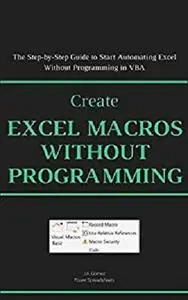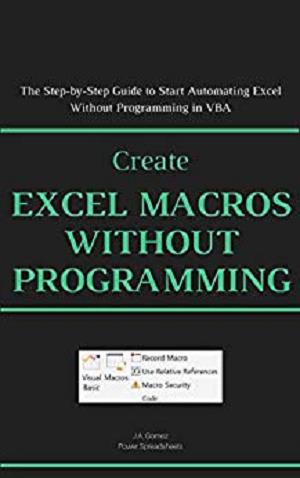Create Excel Macros Without Programming: The Step-by-Step Guide to Start Automating Excel Without Programming in VBA (Excel Macros for Beginners Book 2) by J.A. Gomez
English | October 21, 2018 | ISBN: N/A | ASIN: B07JDXZBX3 | 119 pages | MOBI | 2.62 MB
English | October 21, 2018 | ISBN: N/A | ASIN: B07JDXZBX3 | 119 pages | MOBI | 2.62 MB
As implied by its title, the main purpose of this Book is to help you start creating macros without programming.
As I explain in "Introduction to Excel Macros & VBA" (Book 1 of the "Excel Macros for Beginners" Series), my experience is that the main reason people shy away from working with macros and VBA is because these tools are usually associated with programming.
However, as you learn in this Book, the association several people make between macros and programming is not always correct. You can work with basic macros without programming.
In other words, Excel has a set of tools and features that allow you start creating, and working with, macros even if you have no programming knowledge or experience.
One of the main goals of this Book is to help you during the first stages of learning how to work with macros and VBA. I am mindful that to learn about, and master, Excel macros and VBA you need to take the right approach.
In this Book, you learn about certain Excel tools and features that are designed to help you work with, and learn about, macros. You can apply the principles, processes and strategies you learn in this Book to create basic but very powerful macros.
In the short term, this Book should help you start creating basic but useful macros. In the medium and long term, the tools and features you learn about help build the knowledge foundation you need to become a powerful Excel macro and VBA user.
This Book is divided in six Chapters.
#1. In Chapter 1, you learn how to set up Excel to work with macros and VBA.
#2. In Chapter 2, you learn about the tool (known as the Macro Recorder) that you work with when creating Excel macros without programming.
#3. In Chapter 3, you learn how to plan and prepare prior to creating a macro without programming.
#4. In Chapter 4, you learn about one of the most important choices you make prior to recording a macro: Whether to use absolute or relative cell references.
#5. In Chapter 5, you learn the step-by-process you can follow to create Excel macros without programming.
#6. In Chapter 6, you learn about the main limitations of the Macro Recorder and how to determine whether a specific situation is suitable for using the Macro Recorder.
This Book is accompanied by a website where you can download several files containing the data and macros used in this Book's examples. The example files inside the Book's website are organized according to the Chapters and Sections of this Book. This makes it easy for you to find what you need as you read along.



